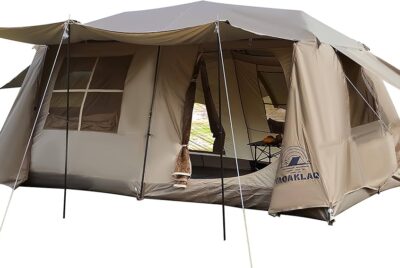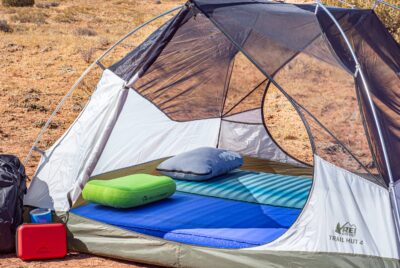Guide to the Best Camping Tent for Your Outdoor Adventures
Introduction
Welcome to the ultimate guide for finding the best camping tent for your outdoor adventures! Whether you’re a seasoned camper or just starting to explore the great outdoors, choosing the right tent can make or break your camping experience. In this comprehensive guide, we’ll walk you through everything you need to know about selecting the perfect camping tent to suit your needs, from types and features to tips for maintenance and care.
Understanding Your Camping Needs
Understanding your camping needs is the cornerstone of a successful outdoor adventure. Begin by assessing the size of your camping group, as it dictates the tent’s capacity. Consider the season and weather conditions of your destination to ensure your tent provides adequate protection against the elements. If you plan to backpack, prioritize lightweight and compact tents for easy transportation. Families may prefer spacious tents with room dividers for privacy. Factor in additional features like vestibules for gear storage or built-in ventilation for comfort. By comprehensively evaluating your requirements, you can select a camping tent that enhances your outdoor experience while meeting your specific needs.
Furthermore, consider the duration and frequency of your camping trips. For frequent campers, investing in a durable, high-quality tent may be worthwhile for long-term use. Evaluate the ease of setup and takedown, especially if you anticipate arriving at your campsite late or in adverse weather conditions. Reflect on your personal preferences, such as interior space layout and tent color. Some campers prioritize natural colors for blending into the environment, while others prefer bright colors for easy visibility. By understanding your camping needs holistically, you can make an informed decision and ensure your tent enhances rather than hinders your outdoor adventures.
Types of Camping Tents
There are several types of camping tents to choose from, each designed for different camping conditions and preferences. From traditional dome tents to lightweight backpacking tents and spacious family tents, understanding the differences between them will help you make the right choice for your camping adventures.
- Pop-Up Tents Pop-up tents are known for their instant setup, requiring minimal effort to pitch. With pre-assembled poles that spring into place, they’re perfect for spontaneous camping trips or events where time is of the essence. Their convenience and simplicity make them popular among festival-goers and weekend campers.
- Geodesic Tents Geodesic tents feature a complex pole structure with intersecting poles, creating a strong and stable frame. They excel in harsh weather conditions like high winds and heavy snow, making them a favorite among mountaineers and expedition campers who require reliable shelter in extreme environments.
- Roof-Top Tents Roof-top tents mount directly onto a vehicle’s roof rack, providing an elevated sleeping platform with built-in mattresses. They offer convenience and versatility for camping adventures, allowing campers to set up camp anywhere their vehicle can access, from remote wilderness areas to crowded campgrounds.
- Hammock Tents Hammock tents elevate campers off the ground, offering a unique sleeping experience suspended between trees. They’re lightweight, compact, and provide excellent ventilation, making them popular among minimalist backpackers and adventurers exploring rugged terrain where traditional tent pitching is challenging.
Key Features to Look For
When searching for the perfect camping tent, several key features deserve attention to ensure optimal comfort and performance during outdoor adventures. Tent capacity is crucial, matching the number of campers with adequate sleeping space. Weather resistance is paramount, with waterproof materials and sturdy construction essential for protection against rain and wind. Easy setup mechanisms streamline the pitching process, while ventilation systems prevent condensation buildup and maintain airflow. Durable materials withstand wear and tear, ensuring longevity in various conditions. Consider additional features such as gear storage options, reflective guylines for visibility, and integrated electrical ports for added convenience. Prioritizing these features guarantees a reliable and enjoyable camping experience.
Budget Considerations
When deliberating on purchasing a camping tent, budget considerations play a pivotal role in decision-making. While quality tents often demand higher investments, it’s essential to align the price with your camping frequency, destination, and durability expectations. Assess how often you’ll utilize the tent and the environments you plan to explore. A higher-quality tent may withstand harsher conditions and offer better longevity, potentially outweighing initial cost concerns. Conversely, occasional campers or those exploring milder climates might find cost-effective options sufficient for their needs. Balance your budget with essential features and durability to ensure your camping investment meets both financial constraints and outdoor aspirations.
.Moreover, it’s worthwhile to consider the long-term value and potential savings that a higher-quality tent can offer. Investing in a durable tent upfront may reduce the need for frequent replacements and repairs, ultimately saving money in the long run. However, for those on a tighter budget, there are still plenty of affordable tent options available that provide adequate shelter and functionality for recreational camping trips. It’s essential to strike a balance between price and quality, ensuring that your chosen tent meets your camping needs while also fitting comfortably within your budget constraints. By carefully evaluating your options, you can find a camping tent that offers the best value for your money and enhances your outdoor experiences.
Tips for Proper Tent Care and Maintenance
Proper tent care and maintenance are essential to prolonging the lifespan and functionality of your camping shelter. Begin by thoroughly cleaning your tent after each use, removing dirt, debris, and any stains with a mild soap and water solution. Allow your tent to dry completely before storing it to prevent mold and mildew growth. When storing your tent, avoid folding it the same way every time to prevent creases and weakening of the fabric. Instead, loosely stuff the tent into its storage sack to maintain its shape and integrity.
Regularly inspect your tent for signs of wear and tear, such as tears, punctures, or damaged seams, and repair them promptly using a reliable tent repair kit. Reinforce high-stress areas like tent poles and zippers to prevent unexpected failures during your camping trips. Additionally, apply a seam sealer to the tent seams annually to enhance waterproofing and prevent leaks.
During setup and takedown, handle your tent gently to minimize stress on the fabric and components. Avoid placing heavy objects directly on the tent floor and use a footprint or groundsheet to protect against abrasions and punctures. When pitching your tent, choose a flat, level surface and clear any sharp objects or debris that could damage the tent floor.
By following these tips for proper tent care and maintenance, you can ensure that your camping shelter remains in top condition for years of outdoor adventures, providing reliable protection and comfort in diverse camping environments.
Conclusion
Finding the best camping tent for your outdoor adventures doesn’t have to be overwhelming. By considering your specific needs, understanding the different types of tents available, paying attention to key features, and budgeting accordingly, you can find the perfect tent to suit your camping style. With proper care and maintenance, your camping tent will be your trusty companion for many memorable outdoor experiences to come.
FAQs (Frequently Asked Questions)
Q: Can I use a camping tent in extreme weather conditions?
A: While many camping tents are designed to withstand a variety of weather conditions, it’s important to choose a tent rated for the specific weather conditions you expect to encounter.
Q: How many seasons should my camping tent be suitable for?
A: Camping tents are typically rated for three seasons (spring, summer, fall) or four seasons (including winter). Choose a tent that suits the seasons you plan to camp in most frequently.
Q: What is the difference between a single-wall tent and a double-wall tent?
A: Single-wall tents have one layer of fabric for both the tent body and rainfly, while double-wall tents have a separate rainfly that provides additional protection from the elements.
Q: How can I prevent condensation buildup inside my tent?
A: To minimize condensation buildup inside your tent, ensure proper ventilation by leaving windows or vents open, avoiding cooking inside the tent, and using a ground cloth to prevent moisture from rising from the ground.
Q: Are there any eco-friendly camping tent options available?
A: Yes, there are eco-friendly camping tents made from sustainable materials such as recycled fabrics and low-impact manufacturing processes. Be sure to research eco-friendly tent options when making your purchase.




